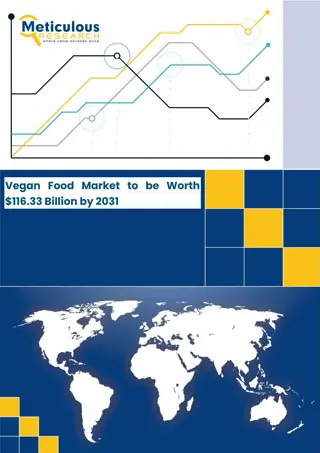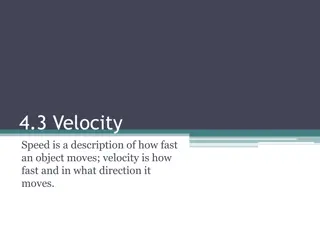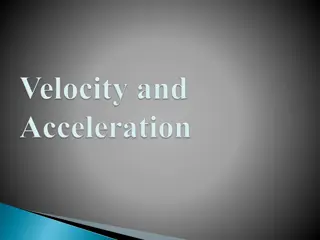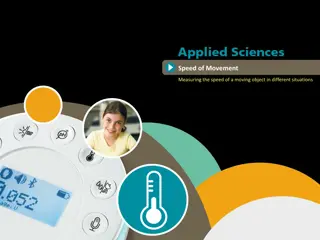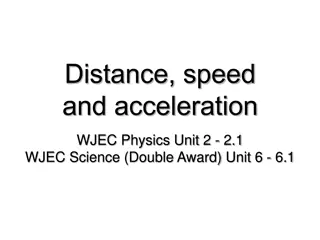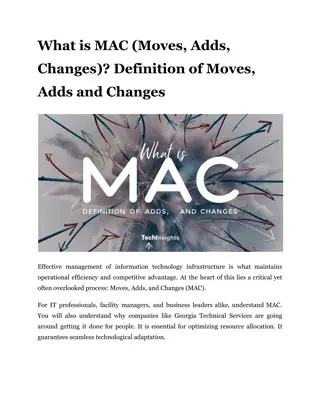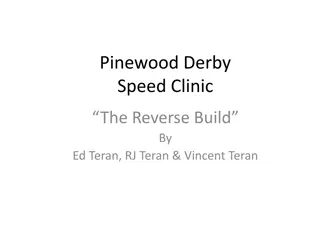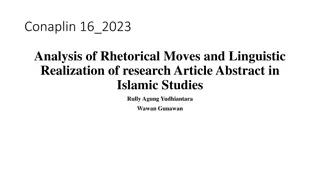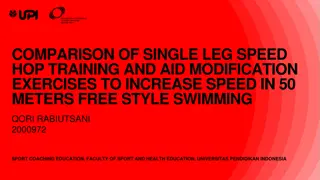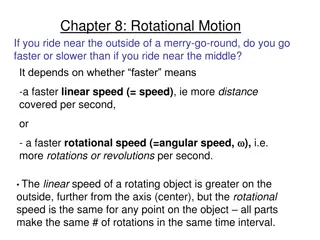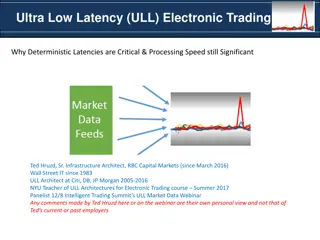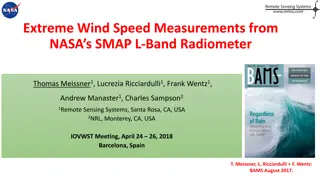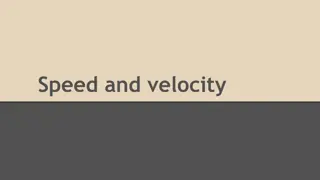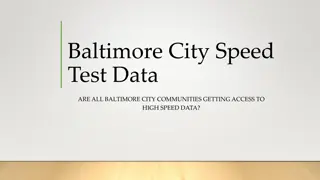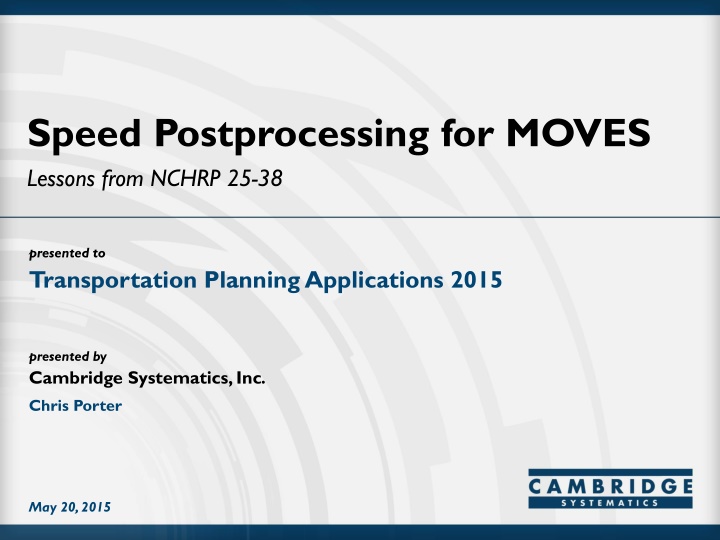
Insights on MOVES Speed Postprocessing & Sensitivity Analysis
"Explore key messages on improving MOVES models through postprocessed speed estimates. Learn about NCHRP 25-38 input guidelines, MOVES inputs sensitivity ranges, and speed-emissions relationships for urban roadways."
Download Presentation

Please find below an Image/Link to download the presentation.
The content on the website is provided AS IS for your information and personal use only. It may not be sold, licensed, or shared on other websites without obtaining consent from the author. If you encounter any issues during the download, it is possible that the publisher has removed the file from their server.
You are allowed to download the files provided on this website for personal or commercial use, subject to the condition that they are used lawfully. All files are the property of their respective owners.
The content on the website is provided AS IS for your information and personal use only. It may not be sold, licensed, or shared on other websites without obtaining consent from the author.
E N D
Presentation Transcript
Speed Postprocessing for MOVES Lessons from NCHRP 25-38 presented to Transportation Planning Applications 2015 presented by Cambridge Systematics, Inc. Chris Porter May 20, 2015
Key Messages Speed distributions are an important MOVES input A cornucopia of observed speed data is becoming available BUT We often need to use modeled speeds for consistency between base and future year assumptions Models don t do a good job of predicting speeds We can improve our current models through Postprocessed speed estimates Adjustments to free-flow speeds Really good speed estimates will require better models 2
NCHRP 25-38 Input Guidelines for MOVES Objective Produce guidelines for transportation practitioners on methods, procedures, and datasets needed to develop and obtain transportation-related regional- and project-level inputs for using MOVES Products Resource document on developing MOVES inputs Sample data and examples Tools for processing data Final report documenting research approach 3
Summary of MOVES Inputs Falling in Different Sensitivity Ranges MOVES Input Temperature Humidity Speed Age VMT Population Ramp Fraction Source Type Detail for Road Type Dist Source Type Detail for Speed Dist Month VMT Fraction Hour VMT Fraction VOC NOX PM Very Substantial Modest Very Substantial Substantial Very Substantial Modest Very Substantial Very Substantial Very Substantial Very Substantial Substantial Substantial Substantial Substantial Very Substantial Substantial Modest Very Substantial Substantial Modest Substantial Modest Modest Moderate Modest Modest Moderate Modest Modest Modest Modest Modest Modest 4
Speed-Emissions Relationship Urban Unrestricted Access Roadways 400% 350% Emissions Relative to Lowest 300% 250% 200% 150% 100% 50% 0% 2.5 5 10 15 20 25 30 35 40 45 50 55 60 65 70 75 Speed (mph) NOx VOC CO2e PM2.5 (trucks) 5
MOVES Speed Sensitivity Analysis Comparison Made Source VOC NOX PM Average speed distribution (overall distribution based on varying congestion levels, worst case road types shown) Average speed distribution (reduce HD vehicle speed by 5 mph) Average speed distribution (decrease average speed from 90th to 10th percentile based on NEI submittals) PC: PC: PC: -15% to +83% CT: -29% to +120% -5% to +20% CT: -8% to +57% -12% to +43% CT: -20% to +53% (1) (2) +1% +2% +6% (3) +8% +10% +16% PC = Passenger Car; CT = Combination Truck; HD = Heavy Duty; NEI = National Emissions Inventory 1. Noel, G., and R. Wayson, 2012, MOVES2010a Regional Level Sensitivity Analysis, Volpe National Transportation Systems Center, prepared for Federal Highway Administration, DOT-VNTSC-FHWA-12-05. 2. Cambridge Systematics and Eastern Research Group, 2015, Input Guidelines for Motor Vehicle Emissions Simulator Model: Practitioners Handbook, NCHRP Web-Only Document 210. 3. Koupal, J., et al., 2013, Study of MOVES Information for the National Emission Inventory: Final Report, Eastern Research Group, prepared for Coordinating Research Council, CRC Report # A-84. 6
Example Average Speed Distribution Input sourcetypeID roadtypeID hourdayID avgSpeedBinID avgSpeedFraction 11 11 11 11 11 11 11 11 11 11 11 11 11 11 11 11 x 13 source types x 4 road types x 24 hours of day x weekday versus weekend 2 2 2 2 2 2 2 2 2 2 2 2 2 2 2 2 185 185 185 185 185 185 185 185 185 185 185 185 185 185 185 185 1 2 3 4 5 6 7 8 9 10 11 12 13 14 15 16 0.0000000 0.0000000 0.0000000 0.0000000 0.0000000 0.0000000 0.0212651 0.0027255 0.0000000 0.0000000 0.0000000 0.0000000 0.3890143 0.0590208 0.5279743 0.0000000 7
Speed Data Sources Base Year/Historical Forecast Year MOVES embedded Stand-alone volume-delay functions Field surveys Travel demand forecasting model Public agency ITS systems Private vendor from GPS/cellphones TDFM speed postprocessing 8
Speed Inputs for MOVES EPA Guidance States expected to develop local estimates for SIP and conformity analysis Recommended approach is to postprocess the output from a local travel demand network model Use of peak and off-peak speed distributions, rather than a distinct distribution for each hour, is acceptable Postprocessed speeds estimated in the validation year should be compared with speeds empirically observed 9
Volume-Delay Functions BPR Formula: S = Sf/[1 + a(V/C)b] S = Predicted mean speed Sf = Free-flow speed (1.15 times speed at practical capacity ) V = Volume C = Practical capacity (defined as 80 percent of capacity) Akcelik Equation: ? 12+8??? ? = ?0+ 0.25? (? 1) + ?? t and t0 = Average and free-flow travel rate T = Time period x = Degree of saturation Q = Capacity Ja= Delay parameter 10
Whats Wrong with Typical TDFM Speed Estimates? Models are calibrated to match traffic counts not speeds Impedances reflect planning time not actual travel time Typically based on v/c ratios for only 1 to 4 time periods per day Usually a simple function of link-level V/C ratios no explicit modeling of intersection delay or spillback from downstream bottlenecks Time-of-day shifting/peak-spreading usually not incorporated 11
Postprocessing Speed Estimates Why and How? Why Apply different parameters to more closely match real-world speed distributions Develop hour-by-hour speed distributions based on hourly volume estimates Steps Allocate link-level VMT for each modeled time period by hour based on hour fractions from traffic counts or MOVES defaults Recompute link-level speeds for each set of hourly volumes Summarize speeds (VHT-weighted) across all links in the model for each hour of the day, for each MOVES road type, to obtain speed distributions 12
Comparison of Speed Data from Multiple Sources Atlanta Travel demand model output, including unprocessed and postprocessed by ARC ITS data from Georgia DOT (freeways only) GPS travel survey data NAVTEQ Jacksonville Travel demand model output ITS data from the Florida DOT (freeways only) INRIX/Here 13
Average Speed Jacksonville Freeways 70.0 60.0 Average Speed (mph) 50.0 40.0 30.0 20.0 10.0 0.0 Overnight AM Peak Midday PM Peak TDFM TDFM - Postproc. ITS 14
Speed Distribution Jacksonville Freeways, AM Peak 0.50 Fraction of VHT by Speed 0.40 0.30 0.20 0.10 0.00 0 10 20 30 40 50 60 70 80 TDFM TDFM_Postproc ITS Speed (mph) 15
Average Speed Atlanta Freeways 70.0 60.0 Average Speed (mph) 50.0 40.0 30.0 20.0 10.0 0.0 Overnight AM Peak Midday PM Peak TDFM - Postproc. 1 TDFM - Postproc. 2 ITS GPS 16
Speed Distribution Atlanta Freeways, AM Peak Fraction of VHT by Speed 0.50 BPR BPR_Jax GPS ITS 0.40 0.30 0.20 0.10 0.00 0 10 20 30 40 50 60 70 80 Speed (mph) 17
Average Speed Atlanta Arterials 45 40 35 30 25 20 15 10 5 0 Overnight AM Peak Midday PM Peak TDFM - Postproc. TDFM - BPR GPS 18
Effect of Time Interval Disaggregation Fraction of VHT by Speed Bin Jacksonville AM Peak Atlanta AM Peak 0.50 0.50 ITS - 5 min data ITS - averaged ITS - 5 min data ITS - averaged 0.40 0.40 0.30 0.30 0.20 0.20 0.10 0.10 0.00 0.00 0 20 40 60 80 0 20 40 60 80 Speed (mph) Low-Speed Operation 19
Effect of Speed Distribution on Emissions Percent of Modeled Emissions versus ITS Speed Distribution Restricted Access Roads, AM Peak Jacksonville Atlanta 140% 140% 120% 120% 100% 100% 80% 80% 60% 60% 40% 40% 20% 20% 0% 0% TDFM - Postproc. (old) TDFM - Postproc. (new) ITS GPS TDFM TDFM - Postproc. ITS Speed Distribution VOC NOX CO2e PM2.5 (trucks) 20
Comparison of Volume-Delay Functions 70 60 50 Speed (mph) 40 30 20 10 0 1.05 v/c 0.50 0.55 0.60 0.65 0.70 0.75 0.80 0.85 0.90 0.95 1.00 1.10 1.15 1.20 1.25 1.30 1.35 1.40 1.45 1.50 1.55 1.60 BPR JAX BPR MTC BPR ATL AM MTC Akcelik DVRPC 21
VDF Impact on Speed Distribution Fraction of VHT by Speed Bin, Atlanta Freeways, 7:00 to 8:00 a.m. 0.5 (old) ARC Model BPR Default BPR Jax BPR MTC BPR CS-JHK Akcelik ARC Conical ITS 0.4 0.3 0.2 0.1 0 2.5 5 10 15 20 25 30 35 40 45 50 55 60 65 70 75 Average Speed (mph) 22
Conclusions Postprocess your TDFM speeds At the very least, base on hourly V/C ratios Don t use default BPR coefficients No VDF gives a great match with observed speed data May underpredict or overpredict low-speed operation VDFs show a peak at the free-flow speed but miss higher speed bins 23
Conclusions (continued) Calibrate speed *distributions* against observed data? If we do this for present conditions, will it hold up in the future? Aggregation interval of observed data makes a BIG impact What do we mean by speed distribution ? Look carefully at cellphone/GPS data what are we getting? We won t get really good speed predictions until we have models that accurately represent real-world traffic flow phenomenon 24

